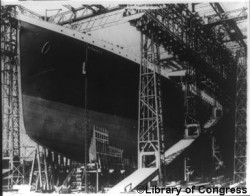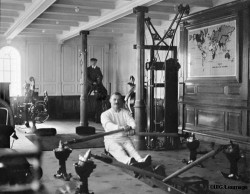R.M.S. Titanic
The R.M.S. Titanic (Royal Mail Steamer) was a masterpiece of early XXth century technology and the pride and joy of England.
It was named as such because besides passengers, it also carried His Majesty King George V's mail.

The Titanic entered Cherbourg habour
The White Star Line and the race to create a giant
The idea of building the Titanic came to J. Bruce Ismay and James Pirrie in 1907 during a dinner in London.
The first was director of the navigation company White Star Line at the time and the second was a senior associate of the company Harland and Wolff, which had built all the White Star Line ships. Their main objective was to compete with their competitor’s Cunard Line who had just launched the Lusitania and the Mauretania.
These two British companies, White Star Line and Cunard Line, shared the transatlantic transport market for North America.
White Star Line wanted to build three ‘superliners’, all bigger, safer and more luxurious than any other in the world. They were due to be launched between 1911 and 1914. These liners were to carry 2,400 passengers, 2,000 tons of freight, sailing at an average speed of 22 knots. White Star Line marketed them more on their capacity, safety and luxurious facilities as well as a regular service rather than their speed.
With these ships, White Star Line could offer a departure from Southampton every Wednesday, arriving in New York six and a half days later.
The Harland and Wolff shipyard
The Harland and Wolff naval shipyard in Belfast (Northern Ireland) was awarded the contract for building these 3 superliners. They had a workforce of 14,000 and were able to work on the construction of 8 ships simultaneously. In order to enable work on the project to go ahead, they transformed three dry docks (where ship repairs were carried out) into two giant docks. A travelling crane almost 75 metres high, the largest ever built, was erected over these new dry docks.

Construction of the boat
The architect Alexander Carlisle and the shipyards head engineer Thomas Andrew, defined the general characteristics of all three liners. With a length of 268 metres and weighing 45,000 tons each, these three new ships would easily outsize the Lusitania and Mauretania. As their names reflected, they were to be the biggest liners in the world: Olympic, Titanic and Gigantic.
At the same time, White Star Line’s General manager J. Bruce Ismay, engaged in talks with the port of New York’s management as there were no quay facilities long enough to dock the new liners there.
On December 16th 1908, workers mounted the 1st part of the keel of the future Olympic and on March 31st 1909, it was the Titanic’s turn. The Olympic was also launched and the ship was transferred to dry dock on October 20th 1910 to complete her fitting out work.
The Titanic was launched in Belfast on May 31st 1911 in front of thousands of spectators, although the ship’s fitting out was not completed until March 1912. Trials were carried out on April 1st of the same year and the ship arrived in Southampton just two days later, where she was to be prepared to sail for New York one week later.
On April 4th 1912, Titanic’s crew made its final preparations before the ship’s grand departure on April 10th.
The ship's technical characteristics
The Titanic was 269 metres long and 28 wide, with a navigation bridge of 22 metres, embarkation decks measuring 24 metres, chimneys 42 metres high and masts reaching 64 metres. The ship had 11 decks, 8 of which were for passengers.
The liner was powered with a 46,000 horsepower propulsion engine including:
- 3 propellers weighing a total of 98 tons (1 4-blade propeller 5m in diameter; 2 3-blade propellers of 7m in diameter)
- 2 alternative steam engines (30,000 HP)
- 1 low pressure turbine (16,000 HP)
- Cruising speed: between 21.5 and 22 knots
- Maximum speed: 24 knots (never reached).
The Titanic was so huge that she required coal reserves equivalent to those of three ships for the crossing, representing 13,000 m3 stored in 12 bunkers. Her burn-up rate was 1.5 kg of coal per meter sailed.
Safety was a major design factor for the Titanic and the ship was doted with a double hull and 16 watertight compartments. The watertight doors were remotely-controlled from the bridge and the ship was designed to still keep afloat with its 2 main compartments flooded.
All the ship’s main gear (boilers, machines, turbines, etc.) were located in separate compartments. In case of water ingress, 5 ballast pumps linked to the 3 pumps in the hold had a water pumping capacity of 400 tons/hour. Smoke and heat detectors had also been installed in all the vital compartments and these were directly linked to a safety centre on board which could ensure rapid intervention.
The Titanic also possessed a modern telephone network for passengers (the luxury cabins could call the bar and the restaurant) and the crew (the chief mechanic could contact the engine room as well as each of the 6 boiler rooms located in different watertight compartments).
The liner had a high-powered wireless system allowing ship-to-land communication. She used two 62-metre masts equipped with antenna used for transmitting radio messages.
The Titanic had a capacity of 3,503 people: 2,603 passengers (905 in 1st class, 564 in 2nd class, 1,134 in 3rd class and 900 crew members).
The capacity of its life crafts was 1,178 people. There were 16 boats (2 with a capacity of 40 people each and 14 able to carry 65 people each) as well as 4 Englehardt life craft (with enough space for 47 people).
In terms of provisions : 34,000 kilos of meat, 7,000 lettuce, 40 tons of potatoes, 6,319 litres of milk, 36,000 oranges and 20,000 bottles of beer were taken on board. Equally large quantities of crockery, cutlery and glassware were required: 12,000 plates, 2,500 water jugs, 12,000 forks, 1,200 pudding bowls and much more! 6,000 tablecloths, 25,000 towels and 45,000 napkins were also prepared....
The Titanic’s hull number (390904) almost caused construction work on the liner to be put on hold as when looking at the number in a mirror, workers could read the letters spelling ‘NO POPE’. This fact was considered a bad omen by the Irish Catholic workers at the shipyard...
On board The Titanic
On the morning of April 10th 1912, Titanic set sail with her crew and passengers from Southampton, England. The liner was guided along a waterway leading to the sea by 6 tugs from the Red Funnel Line. The sheer weight of the Titanic was such that the water she displaced caused 6 hawsers from the ship New York moored nearby to break and rapid manoevering was necessary in order to avoid a collision.
On board the Titanic, all classes of society were represented but strictly separated into several levels (1st, 2nd and 3rd class). This rigid subdivision reflected the inequality that existed in the 1900’s as the world was divided according to where a person came from, their education and their fortune. A first class ticket could therefore cost $4,500 compared to $65 for second class and $45 for third class.
Each accommodation class on board had its own separate gangway and decks. The ship itself is luxurious with a refined decoration; the 4 royal suites are sumptuously fitted out. Each suite contained a lounge area, two bedrooms, two dressing rooms and a bathroom with en-suite toilets.
First class passengers (325), mainly aristocrats and rich members of society, had at their disposal a gym, a Turkish bath, a swimming pool, cafés and smoking rooms (reserved for men).
The ladies on board went to the reading and writing lounges. There were 2 hairdressing salons (one in 1st class, the other for 2nd class passengers) and passengers could also buy souvenirs from their voyage such as post cards, pennants, etc.
To reach the vast dining room (30 metres long) with its richly decorated alcoves and stained glass windows, 1st class passengers used a vast Art déco staircase framed by a huge glass dome...
The gymnasium - First class passengers

2nd class passengers (285), including many professors and traders, had many of the same facilities as those in 1st class on other liners. The meals served in 2nd class were even prepared in the same kitchens as those used for 1st class!
3rd class passengers (706) were mostly emigrants leaving to find fortune in the New World. Their travel conditions on the Titanic were better that on most other liners. Although they were confined to the lower decks of the liner, they were accommodated in cabins with 4 to 6 beds (instead of the traditional dormitories) and they had their own dining room where they were served three meals a day (they had to bring their own food on other boats). They also had a lounge area and smoking room available to them.

A cabin of the third class




